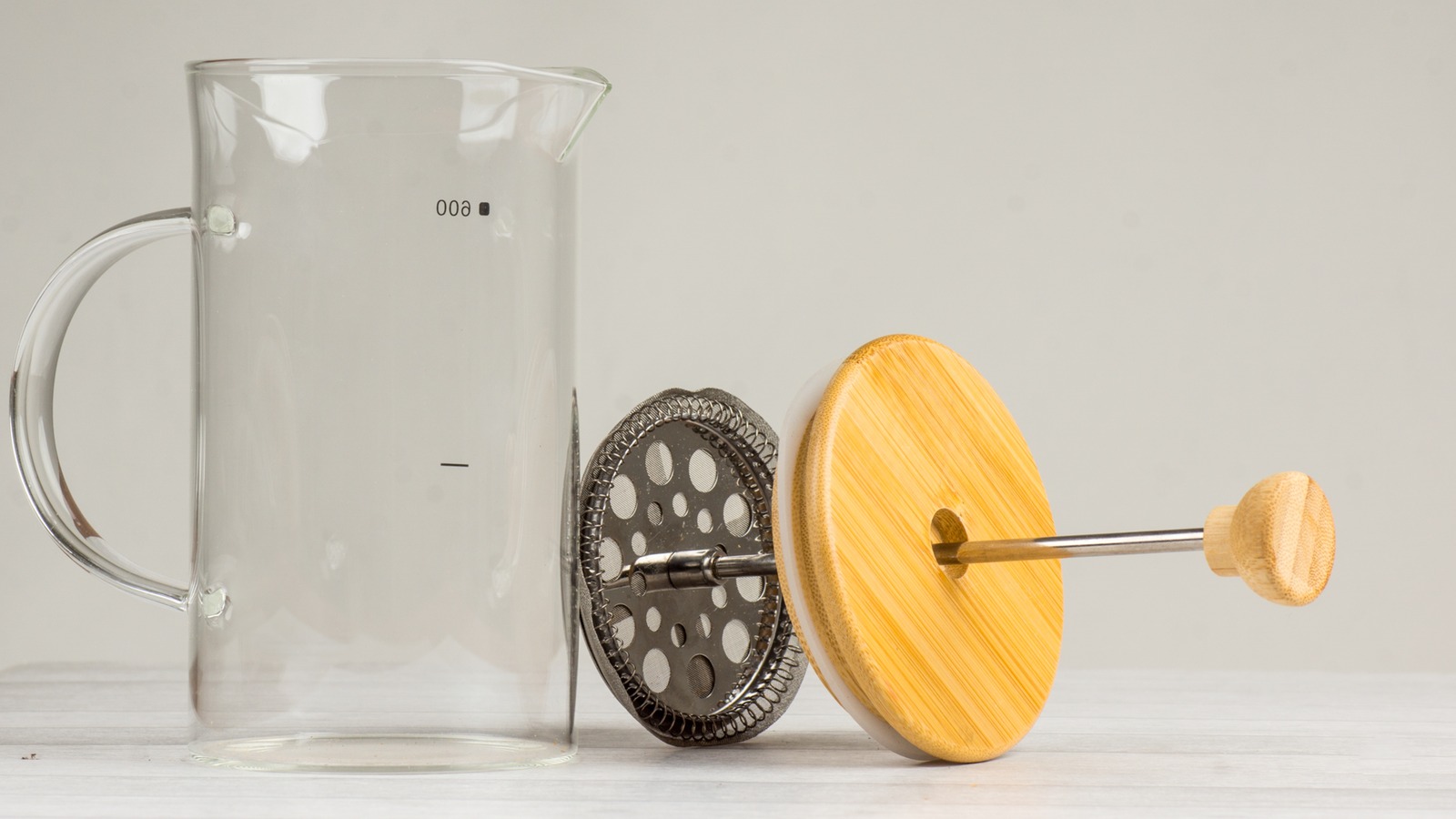Brewing coffee is the obvious use for a French press. It enables complete control over how your coffee turns out and results in the full-bodied flavor that coffee connoisseurs love. However, French presses are capable of much more than that one simple task. We found 14 uses for your French press that aren’t brewing coffee, and when you find out what they are, they may transform how you approach various cooking duties forever.
Whether you make your coffee with a French press or not, the plunging, straining, and containment abilities of these handy kitchen tools are extremely versatile. From steeping tea to frothing milk to rehydrating veggies, they’re much more useful than you may realize.
We researched chef recommendations, recipes, and more to create a list of ways to use French presses. Let’s dive into what we discovered so you can stop selling your handy French press short and learn some valuable tricks along the way.
Steeping loose-leaf tea
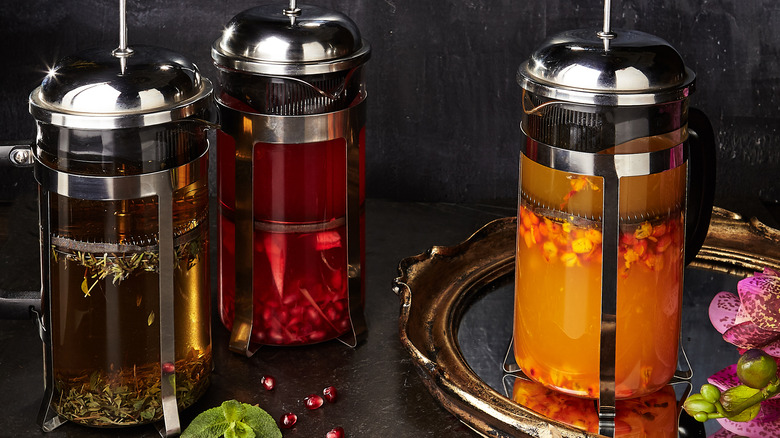
Aside from brewing coffee, steeping loose-leaf tea is the most obvious use for a French press. If you love tea, you’ve probably seen this done or tried it at least once because a press is the perfect tool for the job. Just like with coffee, French presses permit you to add an exact amount of both tea and water, allowing you to maintain complete control over the potency of your drink. They also simplify steeping a large batch or a single serving of tea.
French presses are also ideal if you want to get creative and make your own blend of teas and flavors. Simply create your mix right in the carafe, smell it to ensure the aroma is what you want, and steep like usual.
In addition to curated results, steeping tea in a French press helps eliminate waste. There’s no need for tea bags with their tiny staple, extra paper wrappers, and tags. Instead, you can buy a single tin or large bag of loose-leaf tea without all the extra bells and whistles. If that doesn’t sell you, bags of loose-leaf tea are typically less expensive. Sounds like a win-win, right?
Frothing milk
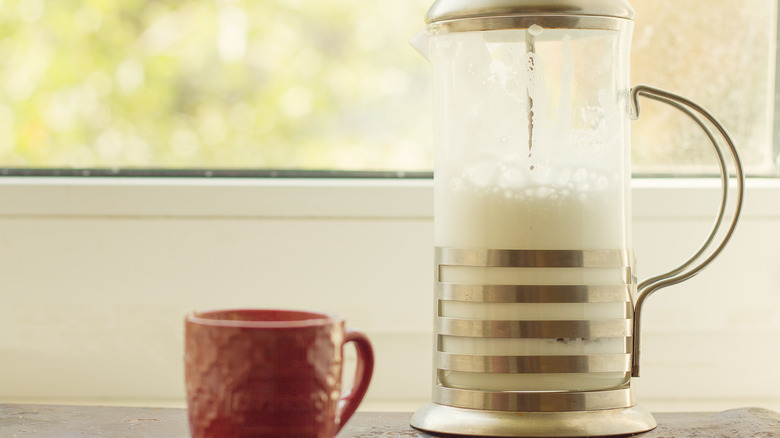
There are a couple of simple gadgets that froth milk, and a French press just so happens to be one of them. A hand pump frother is basically the same device; it just tends to be a bit larger and lacks a fill line for milk. Still, French presses make frothing milk for coffee and other drinks incredibly simple. If you go this route, you do not have to clutter your kitchen with another specific device, either.
To froth milk with your French press, pour milk into the carafe and make sure not to fill it more than halfway. As a general rule of thumb, the milk you froth will double in size, so you don’t want it to overflow or lack the ideal frothy texture. Thanks to the design of a French press, you can use hot or cold milk. However, some say you should always use cold milk when frothing for the best results. Either way, once your milk is in the French press, put the lid on and pump the handle continuously until you reach the desired texture. This could take a few seconds or up to a minute, depending on how much milk is inside, the temperature of the milk, and how rapidly you pump the handle.
Mixing cocktails

French presses may not be traditional bartender tools, but they have lots of the same features. From straining to steeping, infusing, and frothing, they are quite handy when it comes to mixing up tasty cocktails. They make the perfect container for infusing fruit and herb flavors into spirits and making batches of sangria. French presses can also help you thoroughly mix complex hot or cold cocktails without having to purchase additional mixology tools.
Since the carafes on French presses are typically glass, you won’t want to muddle anything in the bottom, but they’re great for mixing and straining. While it is rumored that TikTok users discovered this perfect boozy hack, bartenders have been using strainers to create cocktails for a long time. Straining ingredients allows you to get all the flavors of a drink, like a mojito, without ingredients such as lime chunks and mint leaves clogging up your straw. That’s just one example, but you can see the potential. So, if you want to do it like the pros without buying special tools, your French press is ready to swoop in and take over.
Infusing non-alcoholic drinks and oils with flavors

Marian Weyo/Shutterstock
French presses can also be used to infuse non-alcoholic drinks and mocktails with fresh flavors. Presses make it easy to create flavorful lemonade recipes, fruity cold brew or sun teas, or even water infused with fruit. You can add anything from cucumber to lemon to berries — a drink of your choice — and leave it to work its magic in the fridge for a couple of hours or days. It’s that easy.
French presses are also ideal for infusing flavors into olive oil. Infused olive oil is a great way to enhance the taste of many dishes, including pizza, pasta, meat, salad dressings, and more. Infusing oil adds subtle flavor with minimal effort, and it’s best to make a batch because it takes some time to marinate. Just like with drinks, you simply add the oil and flavors to the container and stick it in the fridge with the lid on for a few days. When enough time passes for the flavors to infuse into the oil, the built-in filter makes separating them effortless.
Straining soup stock
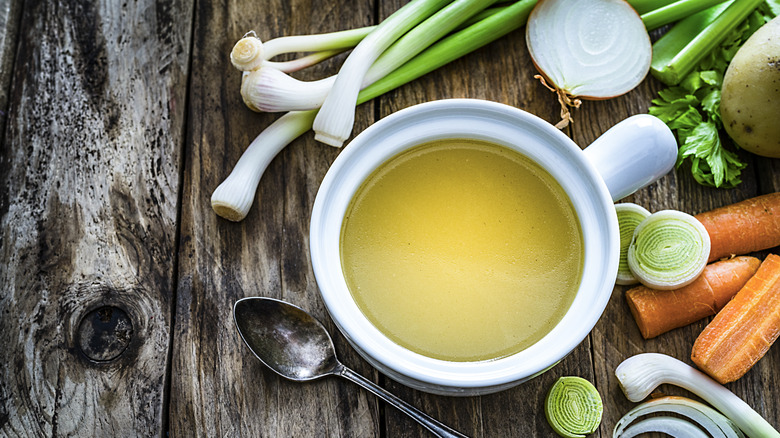
Making a flavorful soup stock doesn’t have to be complicated. However, broths often contain lots of tiny ingredients that need to be strained out after preparation. Technically, you could leave some veggies in, but broth is best when smooth. Plus, if you use vegetable ends, bones, and other leftover bits to make stock (like most people do), you don’t want to incorporate them into your recipes. Not only will they be mushy and unsightly, but someone could choke on a bone.
With all this in mind, straining your soup stock is the best course of action, and luckily, French presses are up for the job. You can pour hot stock into the carafe and use the plunger to separate the undesirable bits. Then, simply pour the stock out of the spout into whatever recipe you are making — or straight into an airtight storage container for use at a later date.
If you are making a large batch of stock, a French press may not be ideal because you’ll have to repeat the process numerous times. But if you don’t have a tool better suited to the task, it definitely solves a problem. Although it may not be the most efficient, the pour spout on a French press helps speed up the process as a whole.
Making whipped cream
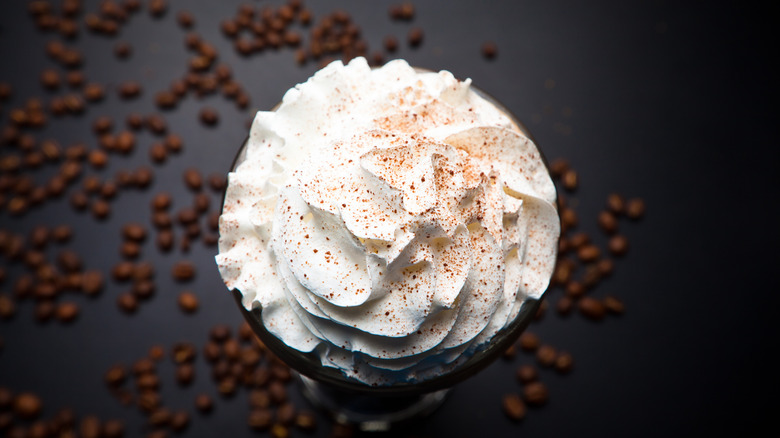
There are several ways to make whipped cream. You can do it with a mason jar, just about any kind of blender or mixer, and, surprisingly, your French press. French press whipped cream may not be the easiest or quickest option, but it works. It may be challenging to achieve super stiff peaks, too. At least you can toss most French presses straight into the dishwasher, though, so cleaning up is virtually effortless.
To make whipped cream in your French press, fill it with heavy whipping cream less than halfway. Put the lid on top and start pumping the plunger up and down rapidly. Make sure to hold the carafe steady with your other hand to avoid a potentially large, sticky mess. In about five minutes, you should have usable whipped cream. Of course, you can easily check your progress at any time by lifting the lid and examining the texture. If it’s not ready, simply pump some more air in until you get it right.
Considering how hard you have to work to pull this hack off, it’s probably only a viable option when you’re making small batches of whipped cream. Chances are good that making a second batch is off the table for most people. But if pulling out a food processor or other more complicated tool to clean sounds unappealing, go ahead and give your French press a try.
Juicing soft berries and citrus fruits
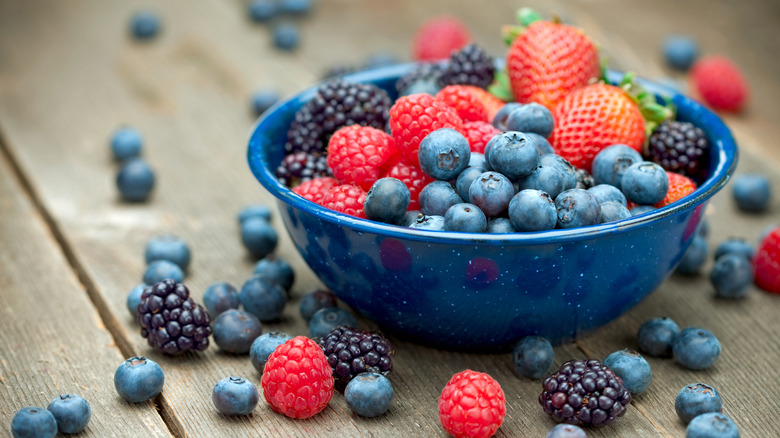
Fresh-squeezed fruit juice is delicious and nutritious, but what if you don’t have a juicer? Well, your French press may be able to help (at least with softer berries and citrus fruits). It won’t do nearly as good a job as an actual juicing machine or cold-press system, but it’ll make something passable. At the very least, you’ll have a nice smashed fruit compote that can be used to top ice cream and pie, infuse drinks with yummy flavor, and more.
Juicing berries with a French press is done just how you’d expect. Add a thin layer of berries to your French press, put the lid on, and apply gentle pressure with the plunger. Lift and reapply pressure repeatedly until the berries flatten, and the juice is extracted. Then, with the plunger depressed, pour the juice out of the spout. Repeating the process several times should give you a fair amount of juice. However, due to the fragility of the mesh strainer, be gentle. Soft berries like raspberries, blueberries, and blackberries work best. You can also use this technique to extract some juice from thinly sliced citrus fruits — but cut the rinds off first. In addition, room-temperature fruit is best. Your French press doesn’t stand a chance against frozen berries.
Rinsing grains
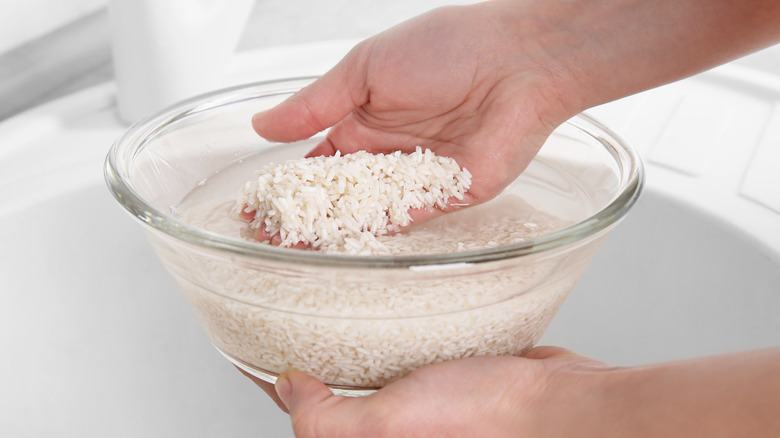
Your French press can also be used to rinse small grains and seeds like rice and quinoa. Presses are exceptionally good at it, too. As opposed to colanders, which easily allow tiny grains to escape through their straining holes, French presses ensure not even a single grain goes to waste. The mesh strainer at the top is much finer than your average colander’s holes. Plus, the carafe effortlessly keeps everything contained, so it’s essentially mess-free.
To effectively rinse grains with a French press, add the desired amount to the carafe. Then, cover them with water and stir to break up any debris. Place the lid on top, depress the plunger, and pour out the contaminated water. You may want to repeat this process for the best results, but either way, you’re left with perfectly rinsed and strained grains.
When you’re done, cleaning up is as easy as rinsing your French press and tossing it in the dishwasher. Not all French presses are dishwasher safe, but most are. If you’re uncertain, just check the manufacturer’s website.
Cleaning and draining veggies
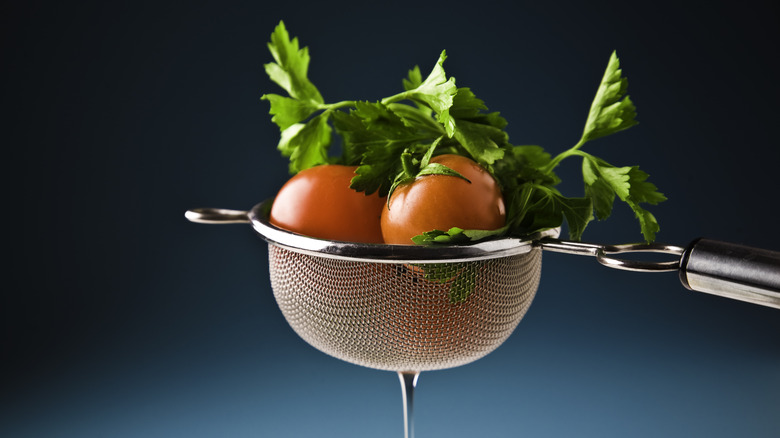
Typically, people reach for a colander when cleaning vegetables. They have a wide opening, enough room to move veggies around inside, and, of course, a built-in drainage system. But what if you don’t have a colander available, it’s already dirty, or it’s holding something else? Well, in a pinch, your French press is ready to step in and save the day.
Due to the restricted size of a French press, you’ll want to rinse the dirty vegetables in question in your hands. Then, give them a good shake to remove some moisture and put them in your French press carafe. Put the lid on top and turn to the side, allowing any excess water to drain out the spout.
Admittedly, this method is only functional for small amounts of veggies (like single servings), and it isn’t ideal for large leafy greens, but French presses can strain water. So, if you don’t have a colander to put your wet vegetables in, your French press can fill the gap.
Making cold brew coffee
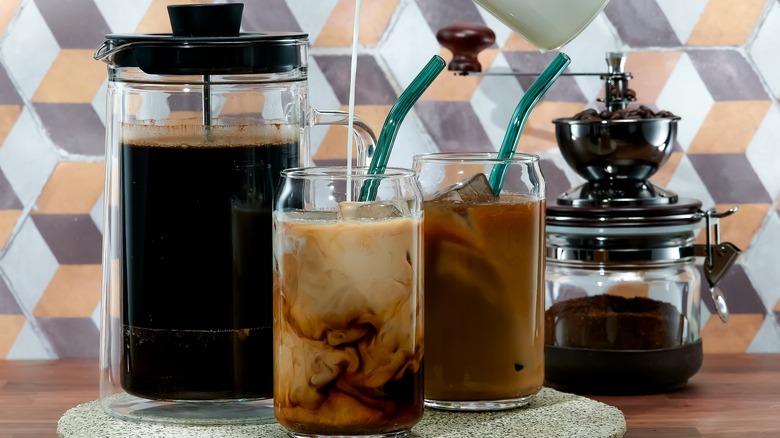
Alright, we know cold brew is still coffee. So, this hack isn’t really using your French press for something other than coffee. Still, using one to make cold brew is a different process, and you may not have thought of it before. Unlike the traditional French press method, which uses hot water, cold brew stays cold from start to finish. As a result, it needs a considerable amount of time to brew. If you don’t have a specific pitcher with a fine mesh straining system, French presses are the obvious solution. They have all the necessary components and easily fit in the fridge for prolonged brewing.
Just like with hot coffee, start by putting coffee grounds at the bottom of your French press. Then, top it off with cold water, put the lid on with the plunger up, and stick it in the fridge. After about 12 hours, it should be ready to enjoy. Of course, if you like a more potent brew, you may want to leave it for longer, but 12 hours should be good for most people. Making cold brew coffee with a French press also benefits from one final step: Straining it twice. This isn’t always necessary, but it helps catch any grounds that manage to sneak out during the first strain, leading to a smoother texture and a more enjoyable experience overall.
Increasing hoppiness and adding flavors to craft beer

While there are countless flavor-infused craft beers on the market, you can also experiment with making your own flavors at home with a little bit of help from a French press. Depending on the beer you choose, you can play around with a world of flavors, too. Anything from coconut to jalapeño, chocolate, coffee, or citrus fruit has the potential to transform an ordinary beer into something special.
Combine about ¾ of a beer with any flavors you like in the carafe of your French press. Put it in the fridge with the lid on and the plunger up for approximately 30 minutes. Then, depress the plunger and leave it to chill for another 30 minutes before drinking. Craft Beer Joe has some experience using a French press to infuse flavors into beer, and he recommends using dark beers with less carbonation. Or, if you want to use a lighter, more carbonated beer, reduce the amount of time it steeps.
If you’re a beer purist, adding fruits and other flavors to your craft beer may not appeal to you. However, increasing its hoppiness might. Simply switch out the flavors listed above for hops, and in an hour or less, your boring, bland beer will be bursting with hoppy flavor. If you love a super hoppy IPA, this is a quick fix for beers that just don’t have enough bitter, earthy flavor for your taste.
Rehydrating dried beans and vegetables
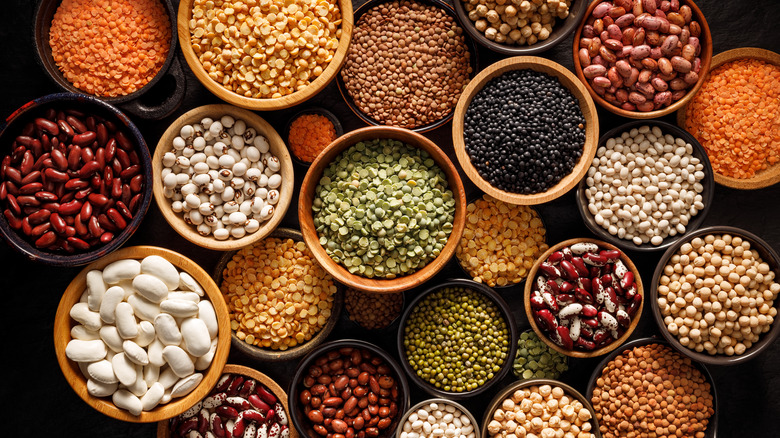
Dehydrated beans and veggies are great for long-term storage in the pantry, but rehydrating them takes a bit of foresight and meal planning. Fortunately, your French press can help. Just like another container or bowl, you can put dehydrated foods in the carafe, add enough water to cover the food (plus 1-2 inches to account for growth), and leave overnight. In the morning, they will be rehydrated.
Another great thing about using a French press is that it can easily accommodate boiling water, which speeds up the rehydration process. Depending on the density of the foods, rehydrating by pouring boiling water over the top could take as few as 20 to 45 minutes. Once the food is appropriately soft, it’ll be ready to add to any recipe you like. Just remember, most foods are dehydrated raw or blanched, so they still need to be cooked.
Storing fresh herbs or cream in the fridge
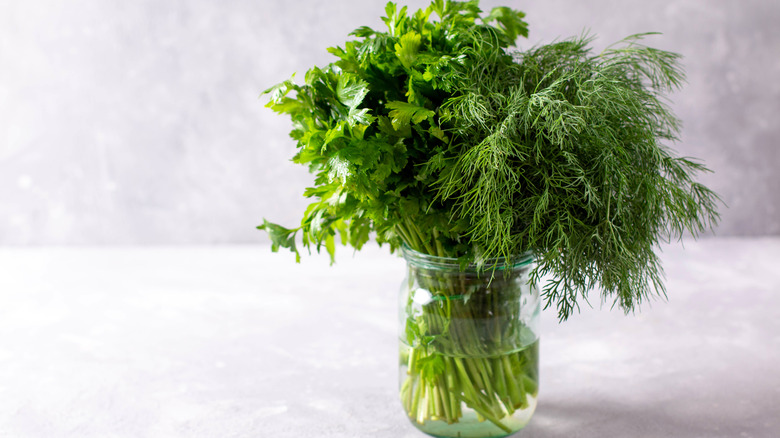
If you rarely use your French press for making coffee and are looking for an entirely different way to keep it from gathering dust, it could make a handy storage container for refrigerated items. You can simply store cream or frothed milk in your press with the lid on. Or, you can use it to store fresh herbs.
There are a couple of ways to refrigerate fresh herbs for maximum flavor and longevity, but tender herbs need to be stored in water, just like fresh-cut flowers. Well, kind of. Tender herbs like cilantro, dill, and parsley are best preserved when standing in a couple of inches of water in the fridge. Placing a loose baggie over the top also helps trap flavor inside. The exception is fresh basil. It doesn’t like the cold, so basil is best left on the counter — but still in water and loosely covered with a bag. Regardless, this is the best way to keep a bunch of cilantro fresh and flavorful. It may sound too good to be true, but your cilantro could retain its full flavor for up to a month when stored using this method.
Self-cleaning
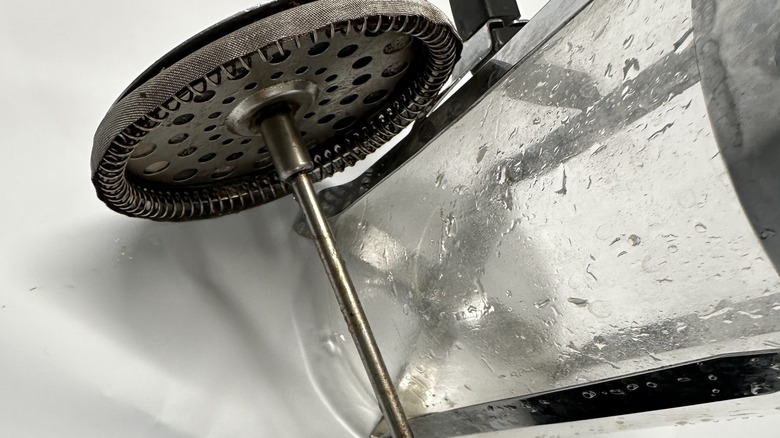
When it comes time to clean your French press, there’s no need for a dish sponge or brush. Thanks to the movable plunger design, the press provides all you need to get it sparkly clean. Well, you’ll also need some soap, but you get the idea. Simply add a drop or two of dish soap and hot water to the carafe, put the lid on, and pump the plunger up and down several times. Just like with milk, it will create a frothy mix that cleans the inside of your French press in an expert fashion. Then, dump out the soapy water and give it a rinse so you can marvel at how quick, easy, and effective this cleaning technique truly is.
While this method does an excellent job of cleaning the carafe, it doesn’t necessarily clean the plunger’s mesh filter and its surrounding support plates super well. It’s better than simply rinsing it off with water, but don’t forget to clean the hard-to-reach parts of your French press from time to time as well.



